|
Information from King Sobhuza II Memorial Park, photos from Swaziland Digital Archives, 2001.
Sobhuza II was the son of Bhunu and Lomawa Ndwandwe. He was born on the 22nd of July 1899 at Zombodze. His father named him Nkhotfotjeni (stone lizard), a name that told a story - when the baby was conceived, the father was living among stones like a lizard because war was threatening between the Boers and the Swazis. His grandmother Labotsibeni (Gwamile) named him Mona (jealousy) as there was jealousy between the Boers and the British, between whites and Swazis and among Swazi royalty itself.
Bhunu died five months later. The royal council met in the byre, deliberated and chose Nkhtfotjeni, who was proclaimed King at the age of four months, and the kingly name of Sobhuza II was selected. Labotsibeni became regent helped by her third born son Prince Malunge. Nkhtofotjeni had to be separated from his mother while she was in mourning. He was sent to his mother's home at Zikhotheni. A year later Labotsibeni decided Nkhotfotjeni should be brought back to Zombodze. This was a time of war between the British and the Boers. When Lomawa's mourning period was over, she joined him at the future capital, Lobamba.
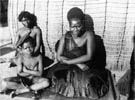 |
 |
| Young Sobhuza with Lomawa (1907) |
Labotsibeni and Buxton (1917) |
When he was old enough, the young King was sent to Zombodze Primary School. This was the first national school, and Labotsibeni had wanted it to be built especially for Nkhotfotjeni. His first teacher was Joseph Xaba (known as Majotane). In 1916 he left for Lovedale in the Cape Province for his secondary education.
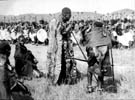 |
 |
| Labotsibeni abdicating (1921) |
Warrior King (1921) |
On the 22nd of December, 1921, Labotsibeni handed over her duties to her grandson at Zombodze royal residence. He was now Ngwenyama Sobhuza II.
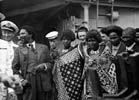 |
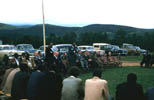 |
| On a battleship (1940's) |
Making a speech (1958) |
Sobhuza believed in peaceful discussion and was against violence. During his rule, he had to negotiate Swaziland's independance from Britain. He managed to do that without bloodshed and Swaziland became independent on the 6th of September 1968. Sobhuza also believd in unity. In Swaziland he worked hard to make a non-racial society. He also preached unity among other African leaders. To encourage the spirit of unity, he made Swaziland a member of the United Nations, the non-aligned movement and the organisation of African unity. He established diplomatic missions in a number of African and Western countries. Sobhuza was also a believer in education, both formal and informal.
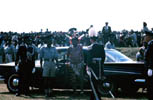 |
 |
| Independence (1968) |
Diamond Jubilee (1981) |
In September 1981, King Sobhuza celebrated 60 years of his rule at his Diamond Jubilee. The nation was also lucky enough to celebrate his eighty third birthday on the 22nd of July, 1982. thousands of people attended the celebration. The King gave a speech on the theme of "Unity is Strength". This was the last time he appeared in public. He died on the 21st of August 1982 at the Embo State House, at the age of 83. At the time of his death, he was the longest reigning monarch in the world. The Swazi Nation was fortunate to have such a leader.
|








